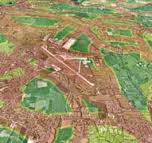An aerial mapping company has produced a prototype map showing where it may be unsafe or even illegal to fly Unmanned Aerial Vehicles (UAVs), commonly referred to as drones. Bluesky has combined its flight planning and 3D aerial mapping with various geographic datasets to come up with the concept of a UAV Flight Restriction Map for the UK.
The map is designed for commercial operators of UAVs and includes ‘No Fly Zones’, areas where further advice should be sought as well as areas where no restrictions on flying are currently in place.
James Eddy, Technical Director at Leicestershire based Bluesky, said: “The UAV industry is rapidly expanding with new operators offering a wide range of services launching every day. With nearly 20 years’ experience in planning large scale aerial surveys, combined with some of the most up to date and accurate geographic data and advanced processing techniques, we have been able to produce this prototype map. It is, however, designed just as a guide to where you can and cannot fly, so UAV operators should still check with the appropriate authorities.”
Background
Operators of UAVs in the UK must comply with Civil Aviation Authority (CAA) regulations if they plan to undertake ‘aerial work’, while those equipped for data acquisition and or surveillance must obtain permission before ‘commencing a flight in a congested area or in proximity to people or property’. An overriding, all encompassing CAA Article also provides guidance in that a ‘person must not recklessly or negligently cause or permit an aircraft to endanger any person or property’, while other restrictions cover the dropping of articles or animals, minimum distances when flying near people or properties, and references to the Data Protection Act.
Bluesky says that its UAV Flight Restriction Map is designed to provide a ‘first stop’ reference for commercial operators of UAVs besides CAA guidelines. The colour coded map uses a traffic light system to identify ‘No Fly Zones’ in red, areas close to no fly zones where further advice should be sought in amber, and ‘Free Fly’ zones in green. This resource takes into consideration population densities based on small scale postcode units, and congestion based on road location and type. The map also considers the location and impact of aerial obstacles, such as overhead power lines, and restricted airspace including no fly zones around airports.
The launch of the prototype map follows attempts around the world to develop control systems for commercial UAV, UAS (Unmanned Aerial System) or drone deployments. NASA, working with the Federal Aviation Administration (FAA) with input from government, industry and academic partners, recently announced plans to develop a UAS Traffic Management System (UTM) to keep track of important information to UAS operators in real time. Visit www.bluesky-world.com.










